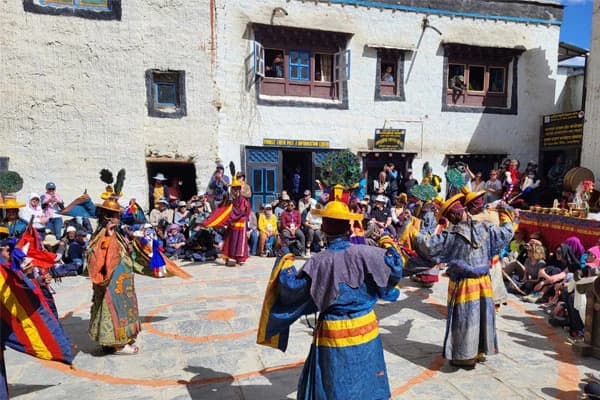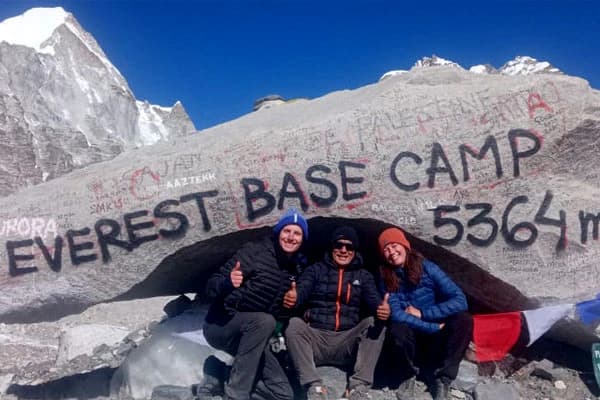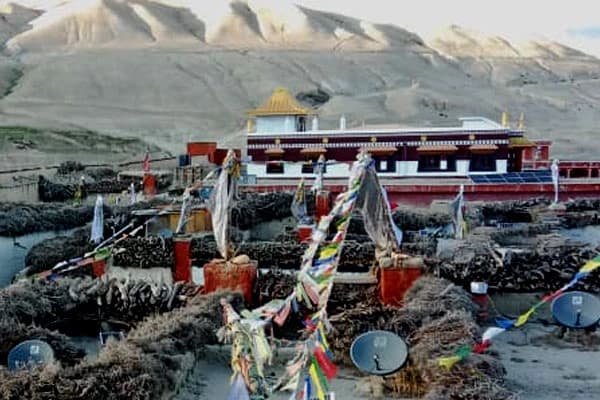Seasonal Variations And Understanding Challenges
Want to be sure about the best time for the Annapurna trek? Well, that's the truth, for timing interferes with everything that you pack! Trekking is best done during spring (March to May) and during autumn (September to November). The weather is constant and sunny, and you also get the best view of the mountain. As this is peak season, trails become crowded. Medium-weight clothes are things to pack as days are rather warm and nights turn cold. Do carry a good rain jacket too for surprise showers. Similarly, these are also perfect times for all Annapurna region adventures including Poon Hill Trek or Mardi Himal Trek.
Winter (December to February) is an off-season for sound reasons. It's too cold! And there are heavy falls of snow. Several tea houses close in these months, so staying accommodations become difficult. So, keep yourself warm by layering up with down jackets, warm sleeping bags, and waterproof items if you dare to go.
Rainfalls are experienced during the months of summer (June, July, and August), so the trails in the mountain are muddy and slick. Leeches start crawling, and the mountain views get covered in clouds. Carry solid waterproof rain gear, extra pairs of socks, and protection against leeches. It's the best time for many trekkers to do the Annapurna Circuit Trek as it lies in the rain shadow area. Hence, you must always pack and gear up appropriately for any season in which you are trekking in the Annapurna Region! If you are having a mentally trembling questions about what to bring and what to avoid, then this detailed blog, regarding the essential gears, will surely quench your questionnare regarding what to pack for annapurna base camp trek.
Essential Gears for Annapurna Base Camp
Backpack And Day Pack
The kind of backpack you carry for the ABC Trek is quite important. Consider 50-60 liters for a big bag, which carries your clothes, sleeping bags, and essentials. But it should not weigh much or rather, it should not be heavy or uncomfortable. You are also expected to have a small day pack (15-20 liters) for daily hikes. Place water, small bites, camera, and jacket in there. Solid straps which are waterproof or are provided with a rain cover are required of good packs.
- Main backpack: 50-60 liters capacity
- Day pack: 20-25 liters for daily essentials
- Padded shoulder straps and waist belt
- A rain cover to keep gear dry
- Multiple pockets for easy organization
- Try it on with weight before buying
Trekking Pole
Trekking poles are indeed wonderful for walking through the mountains! They help you keep balance on the rocky trails and relieve pressure from your knees going downhill. Your legs will surely thank you after so many hours of hiking. Most of the hikers go for two poles, but one could also work. The best-working ones are adjustable because the trail conditions differ. They can even be mighty helpful for you to sound out the ground in front of you for safety.
- Adjustable bar length to suit terrain conditions
- Made of light aluminium or carbon fibre
- Comfortable grip handles
- Wrist straps for security
- Removable baskets for different surfaces
- Collapsible design for easy packing
Water Bottle And Hydration System
Your body needs more water in dry mountain air! At least two water bottles or a hydration bladder system should be carried. In cold weather, insulated bottles are preferred to prevent freezing of water. You can refill water supplies at tea houses along the trail, but please do bring your water purification tablets or filter as the tap water may not be safe to drink. Dehydration worsens altitude sickness so you must keep hydrating.
- 2-3 liter total water capacity
- Insulated bottles for cold weather
- Water purification tablets or a filter
- Electrolyte powder for energy
- Easy-to-reach bottle placement
- Backup water storage options
Backpacking Strategies
Smart packing strategies make the trek to Annapurna Base Camp so much easier! Heavy items pack close to your back and in the center of your pack. Items needed frequently should be placed in external pockets for quick access. Rolling clothes saves more space compared to folding. Keep your rain gear and warm jacket on top so that in case it rains. Pack just enough, and keep your pack light. Heavy items should stay close to the back to maintain balance.
- Heavy items close to your back
- Frequently used items in accessible pockets
- Roll clothes to save space
- Waterproof important items in plastic bags
- Distribute weight evenly left and right
- Pack rain gear and warm clothes on top
Additional Tips
Some additional do's and don'ts of seasoned trekkers they wish they had known before their first ABC adventure! Test all your embarks on at home. Don't realize your setbacks up on the mountain! In case the weather delays you, carry extra food for one day. Mark your equipment with your name and phone number. To endure the wind and the sun, sunscreen, sunglasses, and lip balm are important necessities. Charge all your gadgets until full and carry the power banks. Electricity is rare on this trail. Consider hiring porters whenever your pack becomes too heavy, as it will be of great economic benefit locally.
- Test all gear before the trek
- Bring duct tape for repairs
- Pack extra food for emergencies
- Label gear with contact information
- Consider hiring local porters
- Make a gear checklist and double-check it
Clothing Recommendation for ABC Trek: For the Trailhead
Upper body
- 2-3 moisture-wicking t-shirts or long sleeves
- 1-2 warm fleece or down jackets
- Waterproof rain jacket with hood
- Warm beanie and sun hat
- Insulated gloves and liner gloves
- Buff or neck warmer for wind protection
Lower body
- 2 pairs of quick-dry hiking pants
- 1 pair of hiking shorts for warm weather
- 1 pair of warm thermal leggings or pants
- Waterproof rain pants
- 4-5 pairs of moisture-wicking underwear
- Gaiters to keep stones and snow out of boots
Base layer and thermal wear
- 2-3 long sleeved thermal tops
- 2-3 thermal bottom pants
- Avoid cotton as it takes time to dry
- Choose merino wool for natural odor resistance
- Pack one extra set for sleeping
- Quick-dry synthetic options work well too
Insulating layer
- Fleece jacket for active hiking
- Down jacket for camp and cold weather
- Insulated vest for core warmth
- Choose 700+ fill power down for the best warmth-to-weight
- Synthetic insulation works better in wet conditions
- Pack in a compression sack to save space
Outerwear
- Waterproof breathable rain jacket with hood
- Waterproof rain pants with side zips
- Look for pit zips and ventilation features
- Taped seams for complete water protection
- Bright colors for visibility in bad weather
- Pack it in the accessible pocket of your backpack
Additional tips
- Test your layering system before the trek
- Put at least one emergency dry kit in a waterproofed pack
- Take repair supplies like safety pins and duct tape
- Use merino wool, as this is naturally odour-resistant
- Bright colors help with visibility and photos
- You can buy basic items in Pokhara if needed
- Avoid new clothes, break them in first
- Pack clothes in different bags
Clothing Items While In The Accommodation
Nothing feels better than relaxing and changing into comfortable clothes inside the accommodation at the Annapurna Base Camp Trek. Choosing proper attire for relaxing will aid in your recovery and keep you warm because the nights can get quite chilly up there in the mountains.
Basic T-shirt and Shorts
After all that trekking, good clothes mean relaxing clothes! Carry with you some clean and dry t-shirts and shorts that you can spend during the time around the tea house. These help the skin to breathe and provide rather a cool relief right after a sweating hike. Choose lightweight cotton or synthetic fabric.
Comfortable Slippers
A day on the trail in heavy boots always deserves some reprieve for your feet! Carry light-weight camp silpper like flip-flops or soft slippers to walk around the tea-houses. They keep your feet dry by air and prevent the wound from getting worse. Slip-ons are even better in cold weather. After walking on rocky trails all day, your feet will appreciate it when you have a longer trek, such as a combined expedition.
Thermal Wear
Thermal underwear becomes a likable companion during high-altitude stays. The tea house gets cold at night, more so above 3000 meters. Bring additional thermals as washing is virtually non-existent in the mountains. Merino wool would work best as thermals since they do not retain odors after days of wear.
Fleece-Lined T-shirt and Socks
Indoor warm clothing keeps nights in the mountains comfortable! The fleece-lined shirts keep you warm if the heater in the tea house is not enough. Thick, warm socks keep cold feet at bay during freezing nights. A lot of trekkers on the Mardi Himal and Annapurna Base Camp Trek pack these for maximum comfort at high camps.
Footwear: What To Wear?
Trekking Boots
Annapurna Trekking is a rockier and uneven track thus it is advisable to wear the most comfortable of shoes that is not only waterproof but extremely supportive of the ankle. Also pay attention to your boots and ensure it must have a firm sole with quality grip that would help you find your route in slanted or slope roads. To prevent blisters and pain break the boots in before wearing.
- Buy boots one size bigger than normal (your feet swell during long hikes)
- Test them with thick socks you'll actually use on the trek
- Make sure there's room to wiggle your toes
- Choose boots with good ankle support for rocky terrain
- Pick waterproof but breathable materials
- Break them in for at least 2-3 weeks before your trip
- Consider lightweight hiking boots for better comfort
Types Of Socks
Having the wrong socks can turn your dream trek into a blistering and sore. Merino wool socks are best because they prevent moisture from reaching your skin and keep odour at bay even if you wear them for days. They also keep the feet warm when they are wet, and that happens quite often up in the mountains. Far from just hiking jargon, many experienced trekkers truly swear by this system for preventing blisters. Pack about 4-5 pairs of good socks and they should be of medium thickness, too thin wears away in no time, while too thick makes for tight boots.
Footcare
Later in the evening, examine spots, blisters, or new cuts. In case you are not able to shower, then use wet wipes to wash them. If a hot spot starts developing, stop immediately and apply a band-aid or blister tape. Don't get to the full blistering stage. Let your feet breathe whenever you can while passing through tea house stops. Take off your boots and socks; wiggle your toes a bit and let the soles of your feet breathe. This also keeps away fungal infections and gives tired feet some relief.
Comfortable Sports Shoes
You must take lightweight camp shoes to wear at the tea houses after a hard day of hiking. Your feet cry out to get away from heavy boots, and having comfy shoes to lounge in really lifts the spirits in the evening. Trail runners or lightweight sneakers are great for camp shoes. Some trekkers opt to keep them as backup hiking shoes in case their main ones give them trouble.
Sleeping Bag Recommendations
Comfort for mountain sleeping bags is given the highest priority. Therefore, make sure that it is warm enough for the temperatures you'll be facing. For trekking to Mount Annapurna, the bag has to be valued at least -10°C, as nights in the mountains can get really cold in higher elevations. Down sleeping bags weigh less but synthetic ones are better in wet conditions.
What For?
For winter treks, very warm bags rated for -15°C and colder are required. The tea houses lack heating thus you rely on the sleeping bag to keep warm. For this trek, it is preferable to carry a 3 season or 4 season sleeping bag with sufficient means of insulation. Better for the novice so that hygiene and warmth are more assured than the teahouse blanket which may be of limited cleanliness.
Sleeping Mat And Pillow
A good sleeping mat goes under your sleeping bag, keeping things warm and cosier. Beds in teahouses can be quite thin and cold. Inflatable mats are the best as they're the lightest and most compact. Bring along a tiny pillow or an inflatable one, for that matter.
Thin Lining Cover
Think of a sleeping bag liner as a sheet that goes inside your sleeping bag. It keeps the bag clean, with a bonus of adding a bit of extra warmth. Silk liners are lighter and just as warm but cotton liners feel quite nice. They can come very handy during a warmer trek, when you may feel that you do not need the heft of a heavy sleeping bag.
Travel Documents
- Your passport must be valid for at least 6 months from your travel date
- Get a Nepal visa at the airport or apply online before you arrive
- A TIMS card is required for all Annapurna region treks including ABC
- An ACAP permit to enter into the Annapurna Conservation Area
- Travel insurance documents
- Keep printed flight ticket copies as backup for your phone
- Bring hotel booking confirmations for Kathmandu and Pokhara stays
- Pack 4-6 extra passport photos for permits and official forms
- Write down emergency contact phone numbers on paper
- Some insurance companies require a medical certificate for trekking
- Make photocopies of all permits and keep them in separate bags
Health and safety items
First Aid Kit Requirements
- Pain relievers like ibuprofen for headaches and muscle pain
- Blister bandages
- Antibiotics for severe stomach problems
- It is essential to be hydrated. Put in rehydration salts in case you sweat or have diarrhea
- Take water-purification tablets or a filter bottle every time.
- Use Imodium to treat diarrhea
- Bring antiseptic cream and cuts and scratches
- Basic bandages in different sizes
- Anti-bacterial wet wipes for when showers aren't available
Personal Medicine:
- Any prescribed medicines you regularly take
- Diamox tablets for altitude sickness
- Throat lozenges for dry mountain air
- Motion sickness pills (if needed)
- Electrolyte powders or tablets
- Eye drops
Toiletries: Maintain Your Hygiene
- Biodegradable soap
- Hand sanitizer
- Quick-dry towel
- Toothbrush and toothpaste
- Toilet paper
- Wet wipes
- Sunscreen (SPF 50+) for sun protection
- Lip balm with SPF
- Personal medications
- Small mirror
- Nail clippers
- Basic first-aid items
- Menstrual products (if needed)
- Deodorant
- Hair ties and a brush
Electronics and Gadgets to buy and pack in
- Headlamp with additional batteries: You will want to use these during early morning starts and evening strolls from tea houses.
- Power bank (20,000mAh minimum: Since electricity is scarce in mountains, let alone charging your phone and camera would be important.
- Solar charger: Charges the devices while you enjoy day-long hiking. Make sure it is light and portable!
- Waterproof phone case: Protects your phone against rain, snow, splashes from landing in streams.
- GPS device, or any map app: The primary means of navigation of secondary importance when weather closes trail markers or you became separated by your group.
- Action camera (GoPro style): Wonderful mountain videos and photos that might be impossible for a normal camera.
- Portable solar charger: You no longer have to worry about going on day-long trips without getting access to electric power to charge your phone as conditions of weather (clouds, rain, and snow) will no longer interrupt your charging.
- Portable altimeter: This monitors your ascent and assists you in detecting the signs of altitude sickness.
- Emergency whistle: Minimalistic yet handy to seek assistance in case of loss or injury.
- Universal adaptor and charging cables: The Nepali have a variety of plugs, and dead devices can be a big issue if you don't find something to charge your device with.
- A fitness tracker or smart watch: Monitors heart rate and aids in monitoring the distance covered during hiking on a daily basis.
Essential Packing Gear for Trekking: Season-by-Season Guide
Spring (March To May)
The highest peak season for ABC trekking is spring, with warm days and a clear view of the mountains. The weather is nice but after the sun is gone, it is very gloomy and on higher altitudes, occasionally you will wake up with a little rain shower.
- Fleece jacket with lightweight fabric to keep you warm during the morning and evening hours
- Rain coat to cover the spring downpours unexpectedly
- Medium-weight hiking pants that dry quickly
- Short-sleeve shirts for warm sunny days
- Warm sleeping bag rated for -5°C temperatures
- Sunglasses and sunscreen for strong mountain sun
- Light gloves for early morning hiking
- Quick-dry hiking socks and extra pairs
- Comfortable camp shoes for tea house relaxation
Autumn (September to November)
This season offers the clearest views of the mountains and also the most stable weather conditions. Even when it is enjoyable and warm during the day, the temperature, particularly in the Annapurna Base Camp, will decrease really quickly at the beginning of the night.
- Insulated down jacket for cold evenings and early mornings
- Layered clothing system from t-shirts to warm fleece
- Warm hat and sun hat for different conditions
- Thermal underwear for sleeping comfort at altitude
- Sleeping bag rated for -10°C minimum temperature
- Hiking boots made of waterproof materials that support the ankle well
- Blister-preventing socks and thick hiking socks
- Warm gloves and backup liner gloves
- Headlamp with extra batteries for shorter daylight hours
Monsoon (June to August): Slippery Trails and Challenging Pathways
Monsoons imply rains, muddy paths, and so many leeches! Most trekkers shy away from this but if you get out there, waterproofing is the number one way to safeguard your comfort and safety.
- Heavy-duty waterproof rain jacket with full coverage
- Waterproof rain pants with side zippers
- Gaiters to keep water and leeches out of boots
- Extra pairs of quick-dry socks and underwear
- Waterproof backpack cover and dry bags for gear
- Leech socks or salt for protection from bloodsuckers
- Non-slip hiking boots with deep tread patterns
- Waterproof gloves to keep hands warm and dry
- Extra plastic bags to keep everything dry
Winter (December to February): Cold Day-Hike, Freezing Nights
Winter trekking is for the brave and hardy, those who love snow and extreme cold. The tea houses close down in large numbers, making it the hardest time to attempt routes such as the Annapurna Base Camp Short Trek.
- Heavy down jacket rated for -20°C temperatures
- Insulated winter hiking boots with crampon compatibility
- Thermal base layers for both top and bottom
- Winter sleeping bag rated for -15°C or colder
- Insulated sleeping pad for extra warmth from frozen ground
- Waterproof winter gloves and warm liner gloves
- Microspikes or light crampons for icy trails
- Emergency bivvy sack for unexpected weather delays
- Hand and foot warmers for extra heat
- Insulated water bottles to prevent freezing
- Extra food supplies in case of weather delays
Packing Tips And Tricks For Annapurna Base Camp Trekking
- Put your clothes and your sleeping bag in compression sacks. With the help of these carry-on bags, you can squeeze the air that allows your soft stuff to fit better and leave you with much space in your pack.
- Use packing cubes to organize different types of gear and find things quickly in your pack and bring duct tape wrapped around your trekking poles for emergency repairs of gear or boots
- Share group items like first aid supplies and maps with your trekking partners to reduce individual weight
- Heavy objects should be on your back with some on your sides and some at the center. In so doing, your backpack will be more balanced and lighter as you walk long distances.
- Store things that you use on a regular basis on the outer pockets of your bag. Carry as many of the things you may need fast with you such as water, snacks, sunscreen and more, so you can keep them in a different pocket which you would not need to remove your main pack.
- Wear some layers of clothes instead of taking bulky jackets. Their multilayered structure is what makes you warm on any condition you may experience during your hike in the ups and downs of altitude.
- Take items of clothing that dry fast and can be worn in various situations. To give an example, the clothes that can be converted into shorts are practical; hiking shirts that could be worn in teahouses are helpful.
- Keep your trekking clothes small (two or three only) and only one set of warmer clothes in the evening. You can clean small things from your pack as you go and everyone else on the route deals with the same.
- Check that all your items are in your backpack before heading out. Remove all your things and pack them again until you get a setup that saves weight and is easiest to handle.
- Figure out the difference between what you have to have and what you want. Each extra thing you bring will make carrying a heavy load that much more difficult.
FAQs
Are there any health and safety tips for ABC Trek?
Drinking water should be considered a good remedy for preventing altitude sickness, and climbing slowly so the body can adjust is another method. The first aid kit must contain basic medicines, while daily planning should be informed to someone. Listen to your body; if your body indicates feeling sick or dizzy, rest a little.
How to get ready for the Annapurna Base Camp Trek?
Start two to three months before your trek to Annapurna with daily walking or light hiking. Train with your full backpack on and wear in your boots well. Get your permits, insurance, and everything packed for the season you intend to travel.
Can I do this trek to ABC all year round?
It is possible to do the trek all through the year, but spring and autumn are best due to clear weather and open tea houses. Winter sees snow and thus brings along very cold conditions, while the monsoon will bring rains, mud, and leeches. Most of the tea houses will shut down in winter, so that makes matters harder.
Can I avoid bringing a sleeping bag?
Most tea houses provide blankets, but they are usually thin and not very clean; better to bring your own sleeping bag to maintain warmth and hygiene, since in high altitudes, nights are practically freezing cold, even in warmer months.
Can I get porters to carry my backpack?
Porters are included in your trekking package, so you do not need to pay extra expenses to carry your backpack, and also 1 porter can carry a maximum. 25 kgs that can be shared between 2 hikers.




